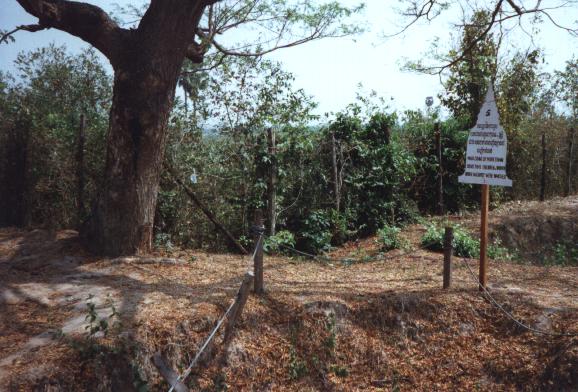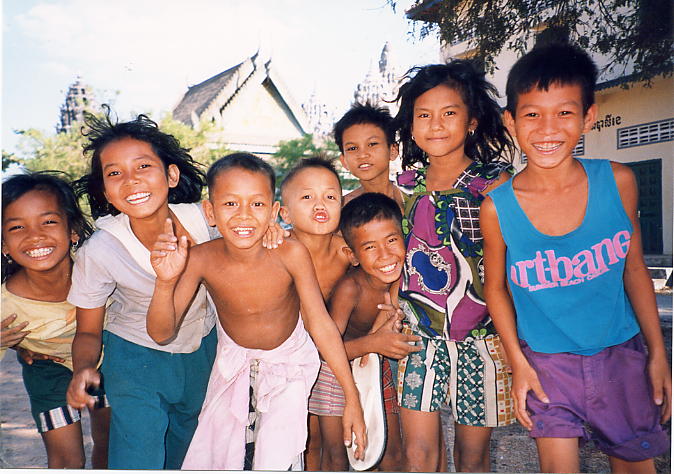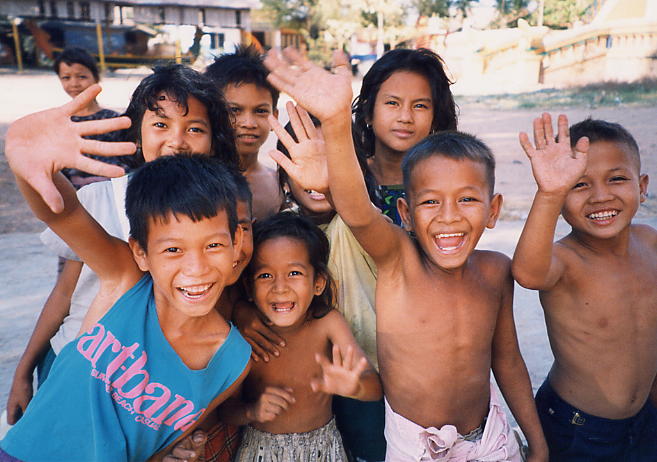ANDYBROUWER.CO.UK
CAMBODIA
TALES 1998
The
Killing Fields of Choeung Ek
The start of the afternoon was hot
and humid as Onphum, my motodub and I made our way through the
traffic-clogged centre of Phnom Penh towards the aptly-named
'killing fields' of Choeung Ek. Our route, south eastwards along
Monireth Boulevard, took us out through the city suburbs and into
the open countryside. At the large glass factory, we veered left
and onto a dirt road, past a pile of rusting cars stacked on top
of each other and through a rural village of stilt houses. The
track narrowed into a rutted single lane, with rice paddies on
either side as Onphum pointed to the left at the turn off to the
Genocidal Centre. Half a kilometre later, we reached the main
gates of the longan orchard turned extermination site. The drive
had taken us forty minutes.
 The compound
was completely deserted, save for a souvenir stall at the far end
of a parking area and a male attendant, sitting on a stool in the
shade of a tree, at the front gate. We parked the moto and paid a
$2 fee to enter the site. It wasn't my first visit but
suprisingly it was Onphum's and he accompanied me throughout in
complete silence, wrapped up in his own thoughts. Immediately you
enter, you're confronted with the impressively-high white marble
memorial chedi that dominates the whole area (left). It has a
characteristically yellow-tiled roof with distinctive Khmer
gables and was erected in 1988 to house the remains of 8,985
victims that were unearthed in 86 separate graves discovered at
the site. These were disinterred in late 1980 and pictures of the
exhumed skulls laid out in neat rows on the ground were some of
the most graphic images I recall from tv documentaries of the
time. The pits had been opened and the bones and skulls removed
to estimate the number of dead. Some of the remains were found
still bound and blindfolded. They were collected and housed in a
simple enclosure constructed of bamboo and thatch as a lasting
reminder of the Khmer Rouge period of terror. It also served as a
memorial where Buddhist funeral rites could be performed to allow
the spirits of the deceased a more peaceful passage to the
afterlife.
The compound
was completely deserted, save for a souvenir stall at the far end
of a parking area and a male attendant, sitting on a stool in the
shade of a tree, at the front gate. We parked the moto and paid a
$2 fee to enter the site. It wasn't my first visit but
suprisingly it was Onphum's and he accompanied me throughout in
complete silence, wrapped up in his own thoughts. Immediately you
enter, you're confronted with the impressively-high white marble
memorial chedi that dominates the whole area (left). It has a
characteristically yellow-tiled roof with distinctive Khmer
gables and was erected in 1988 to house the remains of 8,985
victims that were unearthed in 86 separate graves discovered at
the site. These were disinterred in late 1980 and pictures of the
exhumed skulls laid out in neat rows on the ground were some of
the most graphic images I recall from tv documentaries of the
time. The pits had been opened and the bones and skulls removed
to estimate the number of dead. Some of the remains were found
still bound and blindfolded. They were collected and housed in a
simple enclosure constructed of bamboo and thatch as a lasting
reminder of the Khmer Rouge period of terror. It also served as a
memorial where Buddhist funeral rites could be performed to allow
the spirits of the deceased a more peaceful passage to the
afterlife.
Choeung Ek was in essence the
burial ground for those arrested and tortured at the Tuol
Sleng prison in downtown
Phnom Penh. Some were killed and buried at the prison itself, but
most victims were shipped the fifteen kilometres out of the
capital at night by truck, many still blindfolded, some were even
made to dig their own graves before they were bludgeoned to death
by pick-axe, hoe, iron bar, wooden club or whatever else served
as a weapon of death. The Khmer Rouge refused to waste precious
ammunition on their victims, many of whom were their own cadre
and their families. In addition to the 8,985 victims already
exhumed, another 43 pits have been left undisturbed and the final
shocking total is believed to be well in excess of 10,000.
Incredibly, Choeung Ek is just one of thousands of recorded mass
grave sites dotted throughout Cambodia and is by no means, the
largest.
 The view of
those bleached white skulls lined up, tier upon tier, is both a
powerful and disturbing image. All four sides of the stupa are
protected by clear glass panels but the ground floor level door
is left ajar when the site is open and at close quarters, the
skulls are arranged by sex and age, ie. Juvenile Female
Kampuchean from 15 to 20 yrs old. It's evident from the cracks
and holes in the skulls that many victims died from severe blows
to the head, while on the bottom level is a heap of soiled
clothing, unearthed alongwith the other remains. Each year, on
May 9th, the memorial stupa is the focal point of a gathering to
commemorate Genocide Day, when the 1.7 million victims of the
three year, eight month and twenty day genocidal reign of the
Khmer Rouge are remembered. Off to one side is a small collection
of photographs and maps housed in a scruffy and broken glass
case. One of the maps shows the location of each of the 86
graves, as well as copies of some of the photographs on show at
the Tuol Sleng museum in the capital, including pictures of the
site when the graves were discovered.
The view of
those bleached white skulls lined up, tier upon tier, is both a
powerful and disturbing image. All four sides of the stupa are
protected by clear glass panels but the ground floor level door
is left ajar when the site is open and at close quarters, the
skulls are arranged by sex and age, ie. Juvenile Female
Kampuchean from 15 to 20 yrs old. It's evident from the cracks
and holes in the skulls that many victims died from severe blows
to the head, while on the bottom level is a heap of soiled
clothing, unearthed alongwith the other remains. Each year, on
May 9th, the memorial stupa is the focal point of a gathering to
commemorate Genocide Day, when the 1.7 million victims of the
three year, eight month and twenty day genocidal reign of the
Khmer Rouge are remembered. Off to one side is a small collection
of photographs and maps housed in a scruffy and broken glass
case. One of the maps shows the location of each of the 86
graves, as well as copies of some of the photographs on show at
the Tuol Sleng museum in the capital, including pictures of the
site when the graves were discovered.
 Behind the stupa and the grazing cattle
that roam the enclosure, are the open pits. On closer scrutiny,
it's all too easy to spot the shards of bone and remnants of
tattered clothing underfoot that are washed up after each rainy
season, when the craters fill up with water. Some of the largest
pits are signposted: 'mass grave of more than 100 victims,
children and women, whose majority were naked', 'mass grave of
166 victims without heads' and 'mass grave of 450 victims'. A
large tree (left) stands prominently amongst the graves and I
recalled a television documentary by Sir David Puttnam, the
producer responsible for the film 'The Killing Fields,' which did
so much to focus world attention on Cambodia in the mid-1980s.
He'd explained that the dark red stain running down the trunk of
the tree is the result of where babies and small children were
held by their feet and their heads smashed against the tree
before being flung into an open pit. I felt chilled as I stood
next to that tree and remembered his words.
Behind the stupa and the grazing cattle
that roam the enclosure, are the open pits. On closer scrutiny,
it's all too easy to spot the shards of bone and remnants of
tattered clothing underfoot that are washed up after each rainy
season, when the craters fill up with water. Some of the largest
pits are signposted: 'mass grave of more than 100 victims,
children and women, whose majority were naked', 'mass grave of
166 victims without heads' and 'mass grave of 450 victims'. A
large tree (left) stands prominently amongst the graves and I
recalled a television documentary by Sir David Puttnam, the
producer responsible for the film 'The Killing Fields,' which did
so much to focus world attention on Cambodia in the mid-1980s.
He'd explained that the dark red stain running down the trunk of
the tree is the result of where babies and small children were
held by their feet and their heads smashed against the tree
before being flung into an open pit. I felt chilled as I stood
next to that tree and remembered his words.
Onphum followed a step or two
behind as we wandered around the now peaceful and serene setting.
It was incredibly hot and we shared a water bottle I'd brought
along, without talking. Just as we made for the exit, a car
pulled up and two American tourists, armed to the teeth with
camcorders and expensive cameras, walked in and broke the
silence. Outside the main gate, we walked over to the souvenir
stall to get an ice cold drink from Ritta, who told us that trade
was slow that day and had reduced considerably since the coup
midway through 1997. The arrival of the American's car had been a
cue for a handful of children to gather by the gate and to whom I
handed out some balloons and necklaces, before we were back on
the moto and bumping along the sandy track on our return to the
city.
 We by-passed a couple of arches denoting
entrances to pagodas and detoured to take a look but the wats
were small and undistinquished. As we passed through the suburbs
of Phnom Penh, we pulled into the grounds of Wat Stung Meanchey,
which boasts a large collection of statues, murals and paintings
in bright colours. There are several large green phoenix statues
and the monk's quarters contain the best of the colourful murals.
I joined in a game of 'kop sbek cheung', the Khmer name for
flip-flop throwing with a group of eager children (right), and
found my aim left a lot to be desired, much to their delight and
amusement. They willingly lined up for a group photograph and
sent me on my way with handshakes and smiling faces as we made
our way back to the Renakse hotel. Enroute, I stopped off at the
offices of the Irish charity, Concern at the recommendation of a
friend. The project Manager, Rob Williams was only too happy to
chat about their work and invited me to their forthcoming St
Patricks' Day party, scheduled for my last night in Phnom Penh.
We by-passed a couple of arches denoting
entrances to pagodas and detoured to take a look but the wats
were small and undistinquished. As we passed through the suburbs
of Phnom Penh, we pulled into the grounds of Wat Stung Meanchey,
which boasts a large collection of statues, murals and paintings
in bright colours. There are several large green phoenix statues
and the monk's quarters contain the best of the colourful murals.
I joined in a game of 'kop sbek cheung', the Khmer name for
flip-flop throwing with a group of eager children (right), and
found my aim left a lot to be desired, much to their delight and
amusement. They willingly lined up for a group photograph and
sent me on my way with handshakes and smiling faces as we made
our way back to the Renakse hotel. Enroute, I stopped off at the
offices of the Irish charity, Concern at the recommendation of a
friend. The project Manager, Rob Williams was only too happy to
chat about their work and invited me to their forthcoming St
Patricks' Day party, scheduled for my last night in Phnom Penh.

Cambodia Tales : Messageboard : Next : E-mail
The contents of this website cannot be
reproduced or copied without permission of the site author. © Andy Brouwer 2006
 The compound
was completely deserted, save for a souvenir stall at the far end
of a parking area and a male attendant, sitting on a stool in the
shade of a tree, at the front gate. We parked the moto and paid a
$2 fee to enter the site. It wasn't my first visit but
suprisingly it was Onphum's and he accompanied me throughout in
complete silence, wrapped up in his own thoughts. Immediately you
enter, you're confronted with the impressively-high white marble
memorial chedi that dominates the whole area (left). It has a
characteristically yellow-tiled roof with distinctive Khmer
gables and was erected in 1988 to house the remains of 8,985
victims that were unearthed in 86 separate graves discovered at
the site. These were disinterred in late 1980 and pictures of the
exhumed skulls laid out in neat rows on the ground were some of
the most graphic images I recall from tv documentaries of the
time. The pits had been opened and the bones and skulls removed
to estimate the number of dead. Some of the remains were found
still bound and blindfolded. They were collected and housed in a
simple enclosure constructed of bamboo and thatch as a lasting
reminder of the Khmer Rouge period of terror. It also served as a
memorial where Buddhist funeral rites could be performed to allow
the spirits of the deceased a more peaceful passage to the
afterlife.
The compound
was completely deserted, save for a souvenir stall at the far end
of a parking area and a male attendant, sitting on a stool in the
shade of a tree, at the front gate. We parked the moto and paid a
$2 fee to enter the site. It wasn't my first visit but
suprisingly it was Onphum's and he accompanied me throughout in
complete silence, wrapped up in his own thoughts. Immediately you
enter, you're confronted with the impressively-high white marble
memorial chedi that dominates the whole area (left). It has a
characteristically yellow-tiled roof with distinctive Khmer
gables and was erected in 1988 to house the remains of 8,985
victims that were unearthed in 86 separate graves discovered at
the site. These were disinterred in late 1980 and pictures of the
exhumed skulls laid out in neat rows on the ground were some of
the most graphic images I recall from tv documentaries of the
time. The pits had been opened and the bones and skulls removed
to estimate the number of dead. Some of the remains were found
still bound and blindfolded. They were collected and housed in a
simple enclosure constructed of bamboo and thatch as a lasting
reminder of the Khmer Rouge period of terror. It also served as a
memorial where Buddhist funeral rites could be performed to allow
the spirits of the deceased a more peaceful passage to the
afterlife. 


